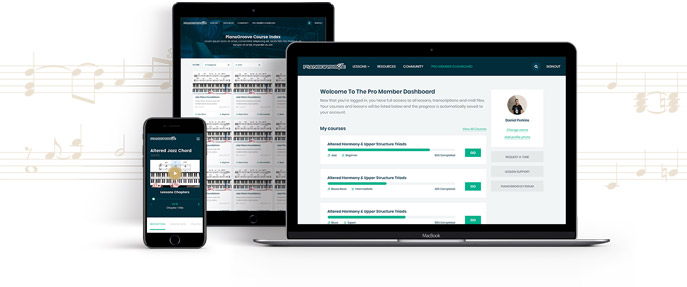
Hayden Hill
Hayden founded PianoGroove in 2015 with the goal of making the world a more musical place. He shares his love for jazz piano through his online courses and manages the community area of PianoGroove.
Live Seminar Resources
Live Seminar Resources
PDF Downloads
- My Foolish Heart - Chord Chart
Join PianoGroove Pro to access all downloads and learning resources.
Download theory supplements, midi files, chord changes and full note-for-note transcriptions of every lesson.
- My Foolish Heart - Transcribe File
Join PianoGroove Pro to access all downloads and learning resources.
Download theory supplements, midi files, chord changes and full note-for-note transcriptions of every lesson.
Related Lessons
Forum Threads
Seminar Description
Seminar Description
Exploring "My Foolish Heart" – Jazz Piano Voicings & Arrangements
Welcome to this lesson on My Foolish Heart, where we explore a range of harmonic techniques, voicing choices, and improvisational concepts for jazz piano. This lesson is designed for pianists looking to deepen their understanding of voicings, spread harmonies, and how to interpret a lead sheet with expressive melodic phrasing.
By the end of this lesson, you will have a strong grasp of voicings for the A and B sections of My Foolish Heart, techniques for smooth voice leading, and strategies for tasteful improvisation.
Simple Voicings for the A Section
We begin by outlining simple voicings for the A section of the tune. This section primarily revolves around the harmony of Bbmaj7, moving through classic 2-5-1 progressions.
Root-Position Voicings
We start by playing root, 3rd, and 7th in our left hand, ensuring clarity and control over the harmonic structure. For example:
- Bbmaj7 → D-7 → G7 → C-7 → F7 → Bbmaj7
By focusing on these core tones, we build a foundation that allows for more complex harmonic movement later.
Using Spread Voicings
To create a richer, more open sound, we explore spread voicings, where the root and 7th remain in the left hand while the 3rd and additional chord tones move to the right hand.
For example:
- D-7 → G7: Instead of simple root-position chords, we can play a D-11 (adding the 9 and 11) resolving into a G13 (including the 9 and 13).
This approach allows for a more fluid, harmonically sophisticated progression.
Inner Voice Movement & Passing Chords
One hallmark of advanced jazz voicings is the subtle use of inner voice movement to create smooth harmonic transitions. In My Foolish Heart, we integrate chromatic passing chords and reharmonizations to bring more color to the lead sheet.
Chromatic Passing Chords
- Between C-7 and F7, adding a Db7 as a passing chord creates a smooth, bluesy movement into the resolution.
- Approaching Bbmaj7, using an A7b9 as a secondary dominant can add more tension before resolving.
These small additions greatly enhance the harmonic depth of the arrangement.
The B Section – Exploring Minor and Altered Harmonies
The B section of My Foolish Heart introduces minor harmony and dominant chords with alterations.
Minor 2-5-1 Progression
The transition into the B section is marked by a minor 2-5-1:
- A-7b5 → D7 → G-7
- Here, using upper-structure triads on D7 (such as an F# major triad) adds richness to the dominant chord.
Using Suspended & Altered Dominants
Instead of playing a simple dominant 7th chord, we explore:
- D7alt (D7#9b13) for a more modern, tense sound.
- G13sus as an alternative, providing a more open and fluid resolution.
This contrast between altered and suspended voicings helps in developing a dynamic interpretation of the piece.
Improvisation Strategies & Melodic Development
Quoting the Melody in Improvisation
A beautiful technique used in jazz ballad playing is to subtly reference the original melody while improvising. Pianist Rio Fki employs this approach effectively in his rendition of My Foolish Heart, using small fragments of the melody to guide his solo.
Triadic and Arpeggiated Motion
One striking element of Rio’s playing is his use of simple triads to create flowing, lyrical improvisation:
- Running Bbmaj7 arpeggios through various inversions
- Emphasizing the 9th and 11th for added color
- Using descending chromatic lines to connect chords smoothly
5 Practice Tips for Mastering This Arrangement
- Start with Simple Voicings – Play root, 3rd, and 7th in your left hand before adding extensions in the right hand.
- Use Spread Voicings – Experiment with 2-handed spread voicings to create a fuller, more balanced sound.
- Incorporate Passing Chords – Add chromatic movement to smoothly transition between harmonies.
- Improvise with Melody Fragments – Base your improvisation on small sections of the melody for a cohesive sound.
- Explore Upper-Structure Triads – Use triadic shapes over dominant chords to add color and harmonic sophistication.
By integrating these techniques, you’ll develop a deeper understanding of how to voice jazz ballads and how to approach improvisation with confidence and creativity. Keep practicing, and enjoy exploring the beauty of My Foolish Heart! 🎶








